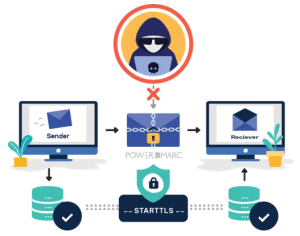Domain security solutions are paramount to making sure businesses of all sizes enjoy a secure experience when it comes to leveraging their domain name. Domain security also ensures cybercriminals cannot dupe your business domain to send out fake messages that appear to be coming from you! This is a real concern for a lot of businesses around the world since in the current times we see a soaring number of phishing incidents.
As a part of this 2024 top 5 countdown series, let’s take a look at a few domain security solutions, including DMARC, that work beautifully to protect your domain against a range of cyber threats.
The importance of Domain Security: Why It Is Non-negotiable
Before we explain the various types of domain security solutions that are available in the market, I would like to introduce you to why this is important. Domains are your digital identity and the face of your business, online. When a web user browses the internet and comes across your website, the first thing that grabs their attention is your domain name. Hence, protecting it at all costs must be your primary objective.
Misusing or abusing a domain name can lead to the following consequences:
- Phishing attacks
- Domain spoofing
- Data theft
- Brand damage
- Financial loss
- Legal troubles
Common Ways Your Domain Can Be Abused
When it comes to business owners, they face a multifaceted range of challenges while securing their domains. Given below are a few examples of domain misuse (commonly known as domain abuse) that can cause potential harm to that security.
1. Cybersquatting (or Domain Squatting)

A cybercriminal can dupe your domain name for malicious purposes. This is essentially what cybersquatting – also known as domain squatting, refers to. In cybersquatting, an attacker registers a domain name that is similar to the domain name of an established company, trademarks, or famous industry names like Amazon. This can have the following effects:
- Phishing scams on unsuspecting consumers
- Used for selling counterfeit products
- Redirecting traffic to other websites
Cybersquatting can be especially damaging to your domain’s reputation and credibility, making others hesitant to rely on your website for information, or your services.
2. Phishing & Pharming Attacks

While pharming and phishing may sound similar, they are two very different attack vectors in email security. Pharming is a DNS manipulation technique. In Pharming, an attacker can redirect genuine traffic to a malicious website – unbeknownst to users. This is achievable by making some alterations at the DNS level and can harm you in many ways, including the theft of sensitive information, and loss of financial assets or personal credentials.
On the other hand, in phishing, an attacker sends a fraudulent email to a user, usually impersonating a legitimate company or domain. The attacker does this in an attempt to fool the victim into submitting credentials, or information that can be used against them.
3. Spoofing Attacks
Spoofing is another popular social engineering technique that can be used to manipulate email receivers into disclosing personal information. In spoofing attacks, a legitimate company domain is spoofed (forged) to send emails from the same domain. This means the domain name used is identical to the original company’s domain name. It is not only hard to detect by humans; the sheer sophistication of this attack makes it harder to discover by even spam filters!
4. Ransomware & Malware Attacks
Bad actors can use a dummy company domain or even a spoofed legitimate domain to distribute malware (malicious software). These domains essentially become storage units for all kinds of malicious malicious, waiting for a single opportunity to wreak havoc!
Malware-laden domains pose severe risks to both individuals and organizations, compromising data and network security. Verizon’s 2019 analysis report suggests that 90% of all malware is delivered via email. The report clearly states: “Figure 18 displays that when the method of malware installation was known, email was the most common point of entry. This finding is supported in Figure 19, which presents data received from millions of malware detonations, and illustrates that the median company received over 90% of their detected malware by email.”
4 Domain Security Solutions Trending in 2024
Let’s explore the top 4 solutions for domain security that are causing an uproar in cyberspace this year:
1. DNS Security Extensions (DNSSEC)
If you need to enhance your Domain Name System protection – DNSSEC is your way to go! DNS communications and responses are encrypted by DNSSEC, working as a verification mechanism to ensure DNS servers cannot be manipulated. This works as an effective blocker against a variety of DNS-based attacks.
2. Domain-based Message Authentication Reporting & Conformance (DMARC)
While nothing is a silver bullet, DMARC definitely comes close! DMARC is an email authentication protocol that has been proven to be effective against phishing, spoofing, and ransomware distribution via email. When you configure DMARC using a DMARC analyzer, you take away one of its primary setbacks – the technical complexity involved in setting up the protocol.
When your emails are in DMARC alignment, you can experience benefits like never before! These include:
- Improvement in email delivery rates
- Improvement in domain reputation
- Ability to get Gmail’s blue verified tick mark with BIMI
3. Mail Transfer Agent – Strict Transport Security (MTA-STS)

As an email receiver, you must make sure you only receive emails that have not been tampered with while in transit. Why? An email that has been tampered with by a bad actor before its delivery might contain:
- Inappropriate content
- Potentially harmful, malware-laden files
- Malicious attachments
- Ransomware
- Redirection link to a spoofing website
This is where MTA-STS steps in. An often overlooked, yet wildly useful email authentication protocol, MTA-STS has the ability to enforce TLS encryption for email messages to ensure they only get decrypted on your end. This blocks access to potential eavesdroppers, lurking in the shadows to take advantage of SMTP’s opportunistic encryption.
4. Domain Security Analysis & Monitoring Tools
Lastly, cybersecurity is a lifelong journey that needs constant optimization and regular monitoring. This is because as technology gets more and more advanced, year after year, threat actors keep on coming up with new ways to launch their attacks. In order to stay ahead of the curve, domain owners must reinvent their prevention tactics and constantly adapt to the changing trends in cybersecurity to stay protected.
I hope this article introduces you to 4 easy ways you can start your journey of securing your email domain. According to AAG’s 2023 phishing statistics, 3.4 billion spam emails are sent every day. Several of these have the potential to cause severe harm to receivers – stripping them of their data and even money! This is the time to take action against cyber threats to take back control of your domain and emails, for a better and more secure future for your organization.

